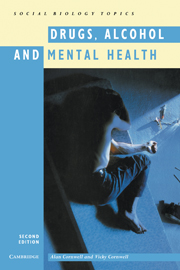Book contents
- Frontmatter
- Contents
- Preface
- 1 Drugs and drug abuse
- 2 Socially acceptable drugs
- 3 Misuse of prescribed and related drugs
- 4 Hallucinogenic drugs
- 5 Opiates and other narcotics
- 6 The biology of alcohol
- 7 The problems of alcohol use
- 8 Prevention and control of alcohol problems
- 9 Help for problem drinkers
- 10 Mental health and mental illness
- 11 Alzheimer's disease and other dementias
- 12 Other mental illnesses
- Further reading
- Index
9 - Help for problem drinkers
Published online by Cambridge University Press: 05 June 2012
- Frontmatter
- Contents
- Preface
- 1 Drugs and drug abuse
- 2 Socially acceptable drugs
- 3 Misuse of prescribed and related drugs
- 4 Hallucinogenic drugs
- 5 Opiates and other narcotics
- 6 The biology of alcohol
- 7 The problems of alcohol use
- 8 Prevention and control of alcohol problems
- 9 Help for problem drinkers
- 10 Mental health and mental illness
- 11 Alzheimer's disease and other dementias
- 12 Other mental illnesses
- Further reading
- Index
Summary
Introduction
Although the consumption of alcohol has probably caused problems throughout the ages, it is only relatively recently that any help for problem drinkers has been available. The first evidence of this was during the Victorian era of very heavy drinking, with the development of the Temperance Movement. This was really aimed at total abstinence. It was then that the term ‘teetotal’ was coined, deriving from a campaigner with a speech defect who had difficulty in saying the word ‘total’. This Movement was linked with the more evangelical branches of the church who preached salvation from the ‘demon drink’.
In the 1930s a more positive form of help was started by the self-help organisation Alcoholics Anonymous. This was followed much later in the 1960s by the development of treatment facilities within the psychiatric services. The approach nowadays is for a wider and more flexible range of help to be provided by voluntary organisations and the health services working together.
At the national level the formation of the charity Alcohol Concern in 1984 has done much to further the cause of reducing harm from alcohol misuse. It has been a valuable resource in the promotion of information about alcohol, in supporting local agencies who are both working to help problem drinkers and providing a wide-ranging, integrated service.
Sources of help
Self help
Self help has always been in evidence and, over the years, some problem drinkers have been able to solve their problems with little or no outside assistance.
- Type
- Chapter
- Information
- Drugs, Alcohol and Mental Health , pp. 75 - 79Publisher: Cambridge University PressPrint publication year: 1993



